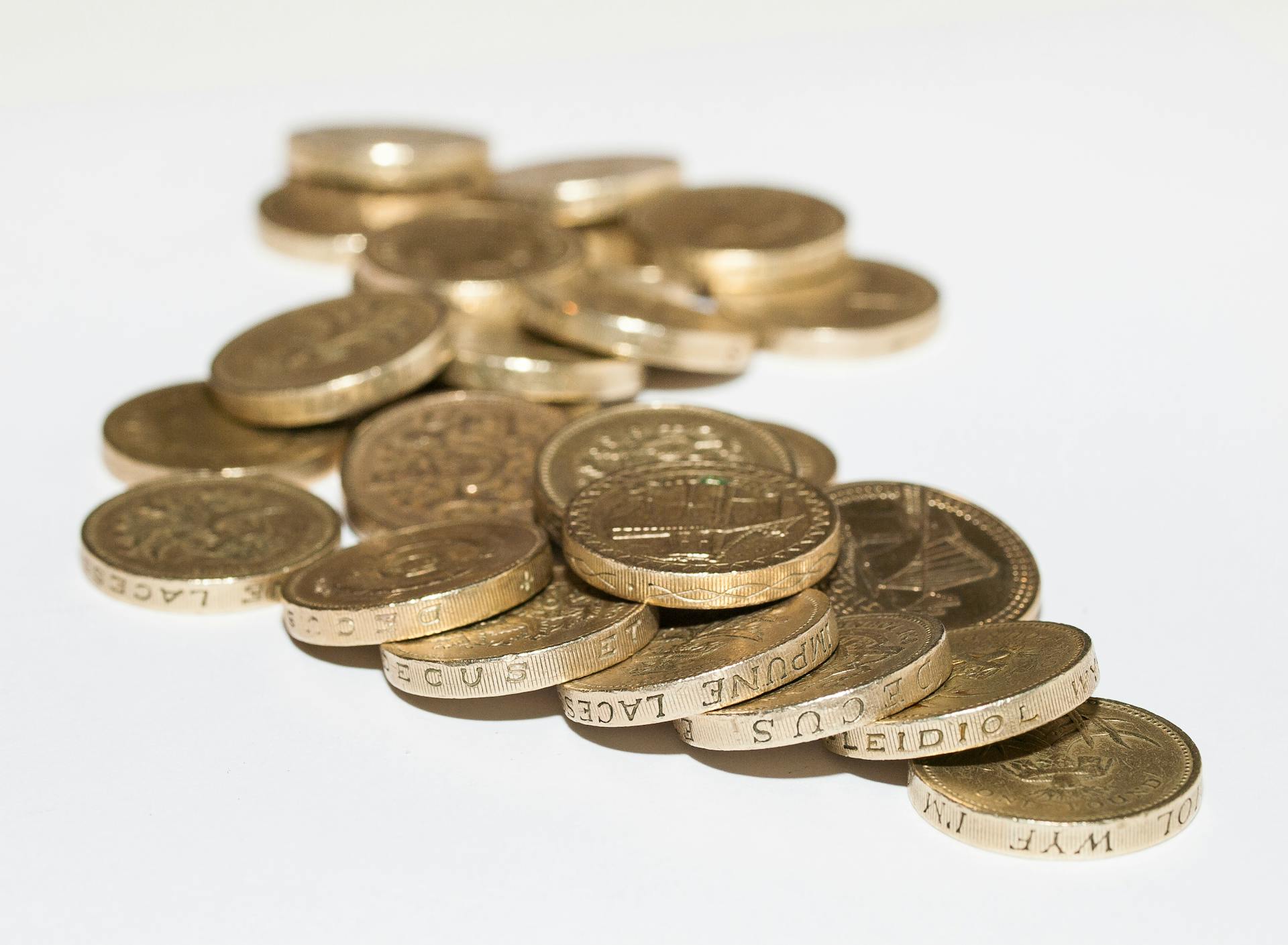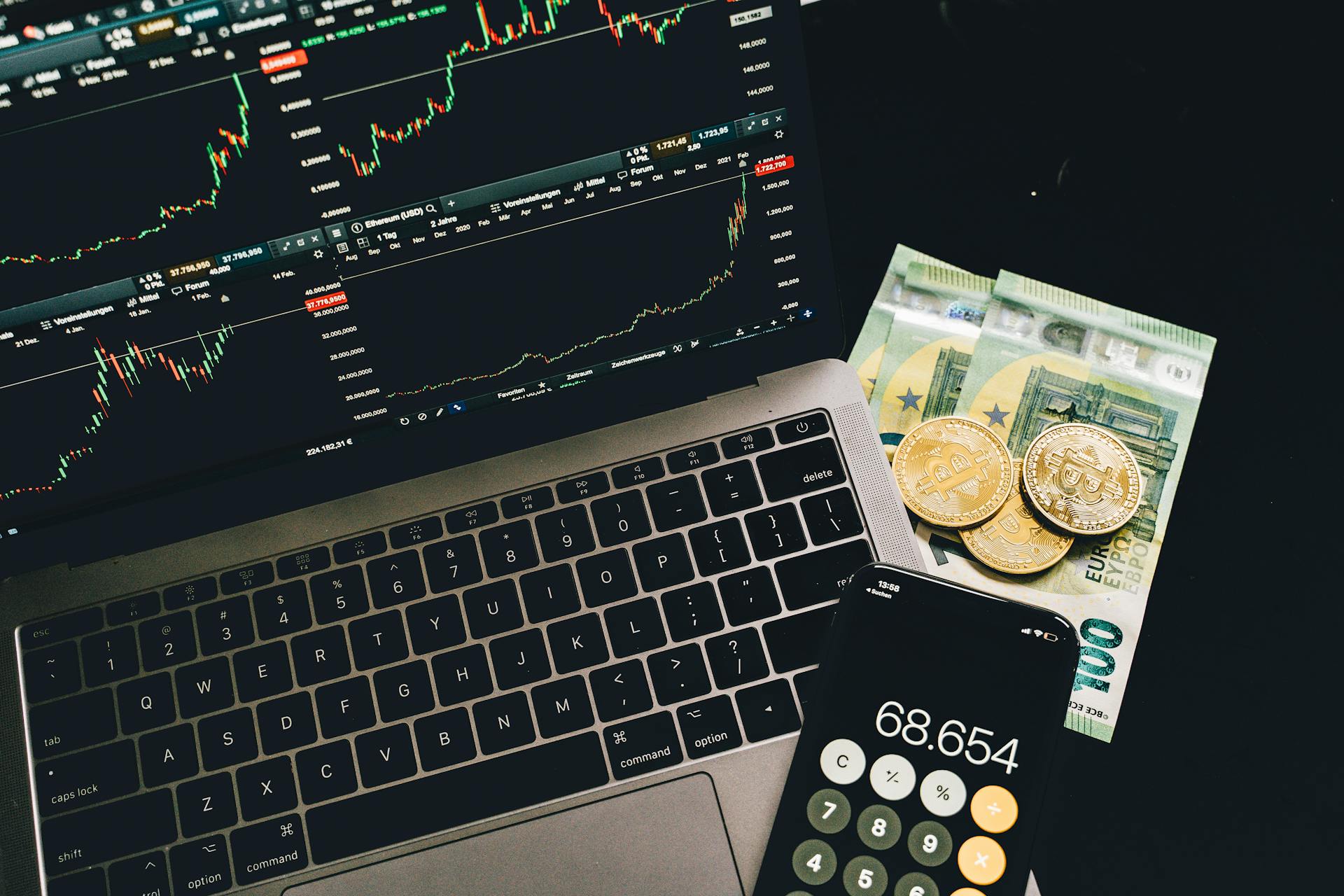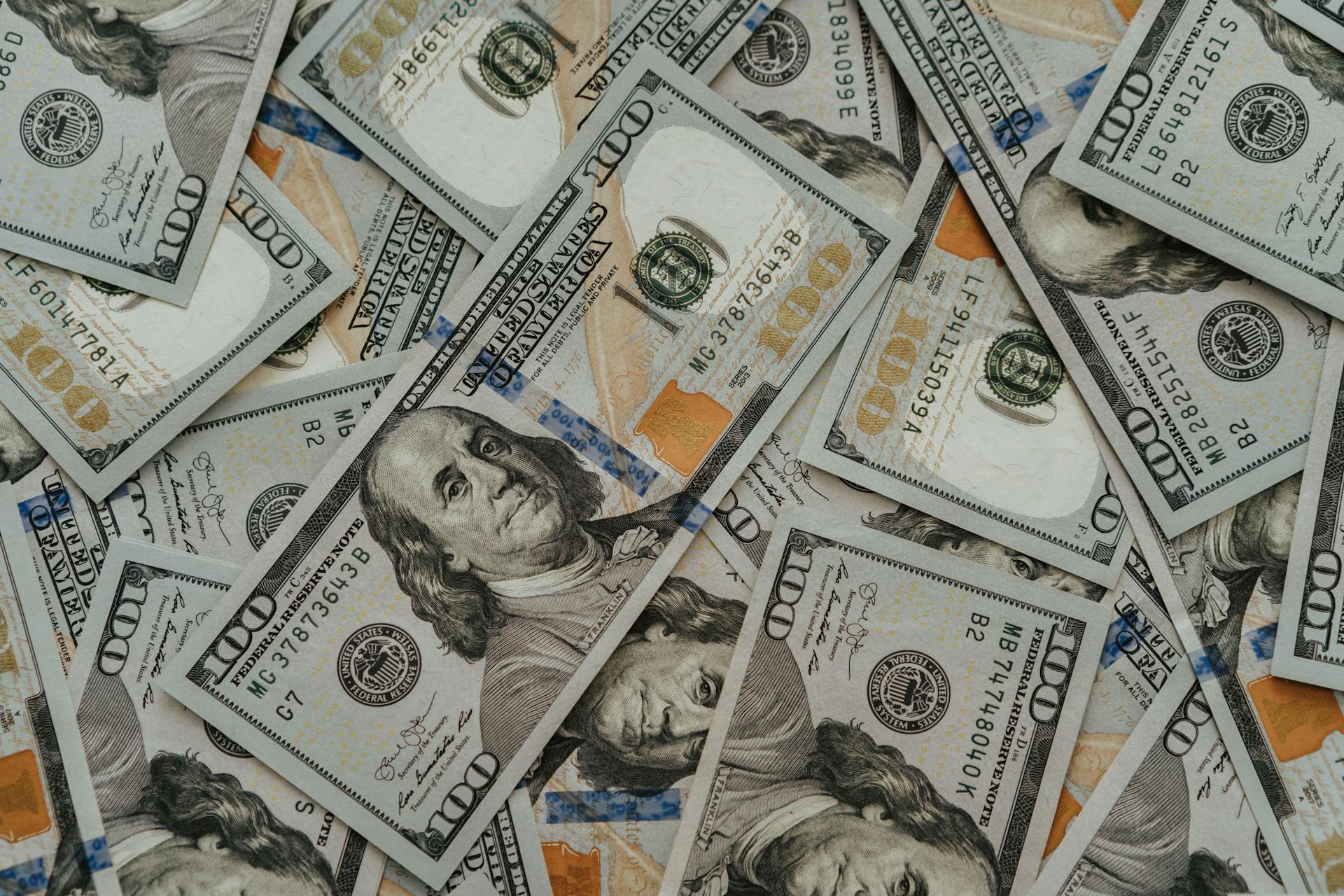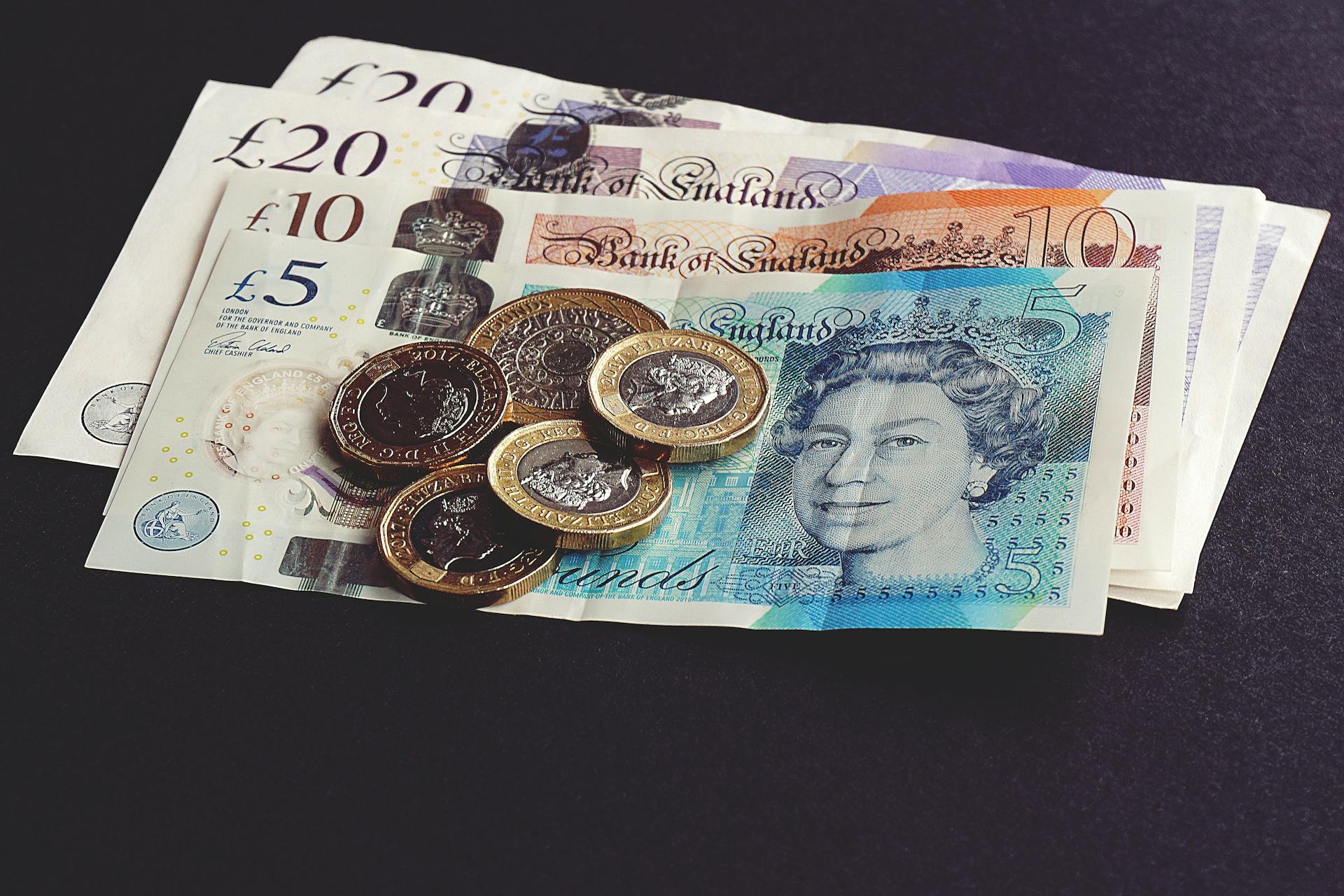
The British Pound, or GBP, is the official currency of the United Kingdom.
The UK has a long history of using the Pound, with the first recorded use dating back to the 8th century.
The British Pound is divided into 100 smaller units called pence.
In modern times, the Pound is widely accepted and used for international transactions.
Consider reading: British Pound vs Japanese Yen
History of the GBP
The British pound has a rich history that spans over a thousand years. The pound became the official currency of the United Kingdom when England and Scotland united in 1707.
Until 1855, the Bank of England wrote all banknotes by hand, a process that was time-consuming and labor-intensive. The British pound was used as a form of money in the year 760, long before it became the official currency.
In the late 19th and early 20th centuries, many countries, including the United Kingdom, tied the value of their currencies to the price of gold. This was known as the gold standard, which offered a uniform way to determine value among world currencies.
Intriguing read: History of Central Bank Digital Currencies by Country
Anglo-Saxon
The Anglo-Saxon period was a significant milestone in the history of the GBP.
The Anglo-Saxons introduced their own system of currency, which was based on the silver penny.
This penny was the standard unit of currency and was widely used throughout England.
The Anglo-Saxons also introduced the concept of the "sterling" standard, which was based on the weight of silver in the penny.
This standard would go on to shape the GBP for centuries to come.
The Anglo-Saxon period saw the emergence of powerful kingdoms, including Wessex, Mercia, and Northumbria.
Each of these kingdoms had its own system of currency, but the silver penny remained the standard unit of exchange.
The Anglo-Saxons were skilled craftsmen and traders, and their currency reflected their economic prowess.
Expand your knowledge: Does Canada Have Their Own Currency
1601 To 1816
The British Pound (GBP) has a rich history that spans centuries. The silver basis of sterling remained essentially unchanged from 1601 to 1816.
During this period, the number of pennies in a troy ounce increased from 60 to 62, making each penny contain 0.464 g of fine silver.
Take a look at this: Silver Rupee
The gold basis of sterling, however, was unsettled until 1717 when the gold guinea was fixed at 21 shillings. This gave sterling a firmer footing in gold guineas rather than silver shillings.
In 1663, the guinea was introduced with 44+1⁄2 guineas minted out of 12 troy ounces of 22-karat gold, making each guinea worth £1 or 20 shillings.
English merchants during this time preferred to pay for imports in silver but were generally paid for exports in gold, particularly due to trade with the Far East.
The British East India Company's indirect sale of opium to China helped alleviate this issue, allowing England to purchase Chinese exports without exporting to other European nations.
Domestic demand for silver bullion in Britain also reduced silver coinage in circulation, as the improving fortunes of the merchant class led to increased demand for tableware.
In 1697, an Act of Parliament raised the minimum acceptable fineness on wrought plate from sterling's 92.5% to a new Britannia silver standard of 95.83% to discourage the melting of coins into silverware.
Related reading: Usd 1 Dollar Note
History of the
The British pound has a rich history that spans over a thousand years. It was first used as a form of money in 760.
The pound became the official currency of the United Kingdom in 1707, after England and Scotland united to form a single country.
The Bank of England was founded in 1694, and it began to issue banknotes from the late 1600s.
Until 1855, the Bank of England wrote all banknotes by hand. This labor-intensive process was eventually replaced by printing.
The British pound served as currency in the colonies of the British Empire, including Australia, New Zealand, and Canada.
Worth a look: United States One-dollar Bill
Pre-Decimal
Before decimalisation in 1971, the pound was divided into 20 shillings, and each shilling into 12 pence, making 240 pence to the pound.
The symbol for the shilling was "s", not from the first letter of "shilling", but from the Latin solidus. The symbol for the penny was "d", from the French denier, from the Latin denarius.
A mixed sum of shillings and pence, such as 3 shillings and 6 pence, was written as "3/6" or "3s. 6d." and spoken as "three and six" or "three and sixpence." 5 shillings, for example, was written as "5s." or, more commonly, "5/–" (five shillings, no pence).
Various coin denominations had special names, such as florin (2/–), crown (5/–), farthing (1⁄4d), sovereign (£1), and guinea (21s, 21/–, £1–1–0 or £1.05 in decimal notation).
By the 1950s, coins of Kings George III, George IV, and William IV had disappeared from circulation, but coins bearing the head of every British monarch from Queen Victoria onwards could be found in circulation. Silver coins were replaced by those in cupro-nickel in 1947.
Here are the subunits of the pre-decimal pound:
The florin coin, valued at one-tenth of a pound, was introduced in 1848 and survived the transfer to a full decimal system in 1971, with examples surviving in British coinage until 1993.
Bretton Woods
The Bretton Woods era was a challenging time for the British pound. On 19 September 1949, the government devalued the pound by 30.5% to US$2.80.
This move was a response to ongoing economic pressure. Sterling came under renewed pressure in 1961, 1964, and 1966 due to speculators selling pounds for dollars.
Tourists were restricted from taking large amounts of cash out of the country, with a limit of £50 in travellers' cheques and remittances, plus £15 in cash. This restriction was in place from 1966 until 1979.
The value of the pound continued to fall, leading to another devaluation in 1967. Sterling was devalued by 14.3% to £1 = US$2.40 on 18 November 1967.
Check this out: 1967 Sterling Devaluation
Decimalisation
Decimalisation was a long and winding road, with formal proposals first made in 1824 by Sir John Wrottesley, MP for Staffordshire.
The first decimal coin in the United Kingdom was the florin, introduced in 1848, valued at one-tenth of a pound.
John Benjamin Smith raised the issue of full decimalisation in Parliament in 1853, leading to the Chancellor of the Exchequer, William Gladstone, announcing that the "great question of a decimal coinage" was "now under serious consideration".
A full proposal for the decimalisation of sterling was tabled in the House of Commons in June 1855 by William Brown, MP for Lancashire Southern, suggesting that the pound sterling be divided into one thousand parts, each called a "mil".
However, due to the hostility of two appointed commissioners, Lord Overstone and John Hubbard, decimalisation in Britain was effectively quashed for over a hundred years.
Sterling was decimalised in various British colonial territories before the United Kingdom, including Hong Kong from 1863 to 1866 and Cyprus from 1955 until 1960.
The UK Government finally decided to include a plan to convert sterling into a decimal currency in the Queen's Speech in 1966.
On 15 February 1971, the UK decimalised sterling, replacing the shilling and the penny with a single subdivision, the new penny, which was worth 2.4d.
Related reading: Gbp Currency Full Form
1976 Sterling Crisis
The 1976 sterling crisis was a pivotal moment in the history of the GBP. It was a time of great economic turmoil, with inflation soaring to nearly 27% in 1975.
James Callaghan became Prime Minister in 1976, and was immediately faced with the daunting task of addressing the economy's problems. The failed Barber Boom and the 1973 oil crisis had left their mark, and financial markets were beginning to doubt the pound's value.
The Wall Street Journal advised the sale of sterling investments in April 1976, warning that the pound was overvalued and that high taxes made it a poor investment choice. The ominous headline "goodbye, Great Britain. It was nice knowing you" still resonates today.
The UK Government was running a budget deficit, and the Labour government's strategy emphasized high public spending. This created a perfect storm that threatened the pound's value.
The US Government feared the crisis could endanger NATO and the European Economic Community (EEC), and stepped in to force domestic policy changes. The International Monetary Fund (IMF) announced the conditions for a loan, including deep cuts in public expenditure, in November 1976.
Origin of the Sterling Name
The British Pound's nickname "Sterling" has a fascinating origin. Reportedly, the U.K.'s currency evolved from sterling silver pennies that were used in the late 700's.
These early pennies were made from high-quality silver, which was a rare and valuable commodity at the time. This association with sterling silver has stuck with the currency ever since.
The use of sterling silver pennies helped establish the UK's currency as a trusted and valuable form of exchange.
Explore further: 1943 Wheat Pennies Worth Anything
Origin of Quid
One theory suggests that the term "quid" came from Quidhampton, a place in England where there was once a royal paper mill. This theory is intriguing, but unfortunately, there's no concrete evidence to support it.
The term "quid" has been used in England since the 17th century, as seen in the Act of Union 1707.
There are various theories about the origin of "quid", but the truth remains unclear.
On a similar theme: British Currency Quid Pound
Currency Features
The British Pound, or GBP, is a highly respected currency globally.
Its physical appearance is distinct, featuring the portrait of Queen Elizabeth II on one side and a design representing the United Kingdom on the other.
The GBP is subdivided into 100 pence, with coins ranging from 1p to £2 and banknotes from £5 to £50.
It's widely accepted and used in international trade, tourism, and finance.
Symbol
The symbol for the pound unit of sterling is £, which has undergone some changes over the years. The Bank of England has exclusively used the single bar variant since 1975.
Historically, a simple capital L was used in newspapers, books, and letters. This style of notation was still used by the Royal Mint as late as 1939.
The pound sign is derived from medieval Latin documents, where "L" was the abbreviation for libra, the Roman pound (weight). This unit of weight became an English unit of weight defined as the tower pound.
Notable style guides recommend using the pound sign without any abbreviation or qualification to indicate sterling. This means you should use £12,000 instead of L12,000.
Currency Code
Sterling's ISO 4217 currency code is "GBP", a combination of the UK's ISO 3166-1 alpha-2 code "GB" and the first letter of "pound".
The code is used to identify the currency in international transactions and financial markets.
In historical and specialist banking contexts, you might come across the abbreviation "stg" (in various styles) to indicate sterling.
Many stocks on the London Stock Exchange are quoted in penny sterling, using the unofficial code "GBX".
Decimal Coinage
The pound has been divided into 100 pence since decimalisation on Decimal Day in 1971. The symbol for the penny is "p".
A decimal halfpenny was issued until 1984 but was withdrawn due to inflation. It was worth 1.2 old pennies.
The old sign "d" was not reused for the new penny to avoid confusion between the two units. This was a deliberate decision.
An amount such as 50p (£0.50) is properly pronounced "fifty pence" but is often pronounced "fifty pee" /fɪfti piː/. This is a common colloquialism.
The word "new" was omitted from coins minted after 1981.
Related reading: Old Wheat Pennies Worth Money
Banknotes
Banknotes are a crucial part of our everyday lives, and they've undergone some significant changes in recent years.
The Northern Bank £5 note, issued in 2000, was the first polymer banknote in circulation, holding this title until 2016.
The Bank of England introduced £5 polymer banknotes in September 2016, marking a shift towards more durable banknotes.
The paper £5 notes were withdrawn on 5 May 2017, making way for the new polymer version.
A polymer £10 banknote was introduced on 14 September 2017, and the paper note was withdrawn on 1 March 2018.
The polymer £20 banknote was introduced on 20 February 2020, and a polymer £50 note followed in 2021.
A unique perspective: Mexican Gold Coins 20 Pesos
Frequently Asked Questions
Is GBP in London?
GBP is the official currency of the United Kingdom, where London is located, and is widely accepted in the city. You can use GBP in London for everyday transactions, including shopping and dining.
Is the British pound and pound sterling the same?
Yes, the British pound and pound sterling are the same, referring to the main unit of the UK's currency.
Is pound sterling accepted in England?
Yes, pound sterling is accepted in England, but it's not the only currency accepted. For more information on currency acceptance in England, click here.
What is the oldest currency still in use today?
The British pound, also known as the pound sterling, is the oldest currency still in use, dating back to around 775 AD. First minted as silver pennies during the Anglo-Saxon period, it has been in circulation for over 1,200 years.
Is the pound still backed by sterling?
The British pound is a fiat currency, not backed by any physical item like gold. Its value is determined by supply and demand in the market.
Featured Images: pexels.com


